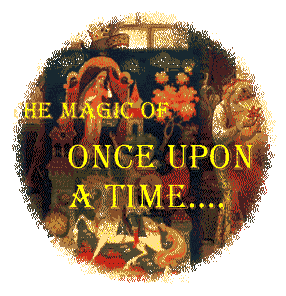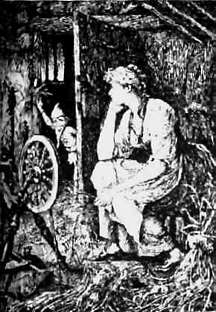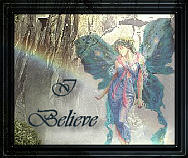|
Narrative Logo - Click for Main Menu Lecture V: Tale Types and Motifs
Taboo Tales While we have looked at Mythological Motifs, Animals, Magic, the Dead (well, coming to it!) and some Marvels, we have pretty much skipped over the Taboo - actually the subject of this lecture's Cinderella tale.
Caption: Rumplestiltskin to the rescue of the Miller's Daughter The cow taboo that we read about in Harris finds its way into the Indian Cinderella, in that dream-logic of folklore. Also, the "name of the helper" tale type is can be a Taboo tale in type C432.1 "guessing name of supernatural creature gives power over him." We see a slight variation of this in Rumplestiltskin (tale type 500--The Name of the Helper). There are over a thousand ramifications of the taboo, or tabu - ranging from the very serious, double obligation Geas of the Old Irish prohibitions to the religious systems of Polynesia and Hawaii. The most familiar taboos surround the forbidden chest, door, or box. Another standard is the lost husband or wife - Orpheus is the best-known example. But we must also watch out for flowers not to be picked, fruit not to be eaten (in Eden, perhaps?), time-limit taboos, not calling a thing by name, not looking back, and not behaving wrong in the presence of supernatural beings . . . .
The Yellow Fairy with fairy dust Many of the tales that we call Fairy Tales are actually tales of Taboo. We looked into fairies a bit two weeks ago - noting that they could be dangerous as well as beneficent. Fairies come in a number of forms, they might be seen as elves, brownies, leprechauns, pixies, and so forth. They often travel in troops, live in isolated places - maybe the hollow of a tree or under a knoll, seem to be unacquainted with fire, and accept tokens gifts as evidence of friendship. However, the taboos associated with fairies are many: one should not eat with fairies; if one spends the night in a fairy camp, one may return to the world but will never be human again; one should never bathe or touch water in a lake in fairyland; one should beware touching fairy bathwater, or get soap or ointment on oneself while bathing a fairy child; fairies can take the "substance" of a thing and leave a sham or shell; they can appear as spirits of the dead or the living; time may pass at a supernatural speed in fairyland; and fairies may play flutes or other instruments to lure the unsuspecting. you might want to watch out for these Fairy Hideaways:
Of course, if you are ever in trouble with a Fairy, you can always open a Bible.
Caption: Magic wand and fairy dust oh, a few more:
As an aside, it's instructive to look at the fairy tales we are familiar with to see what has happened to the taboo element. The Little Mermaid is essentially a fairyland taboo tale in reverse - our Mermaid originates in fairyland, she goes to the "real" world, and, in the Andersen version, she cannot re-enter the land under the waves - a traditional fairyland.
Caption: Tinkerbell In Peter Pan, Tinkerbell is a fairy, and she takes the children to Fairyland. Peter, of course, is the one who cannot return - and even the contemporary endings suggest that this outcome has both literary, social, and psychological overtones.
Rainbow in the clouds Similarly, you will be able to read about The Wizard of Oz and its creation in Zipes, but Dorothy is essentially in a fairyland when she gets to Oz; in Oz, there are Fairy Queens, Wizards, Munchkins, Fairy Witches, etc. abounding. Dorothy does get back, but only with the red shoes (and thereby hangs another tale)! Taboo and fairies are not confined to the mists and moors of the British Isles - in fact, a healthy tradition of fairy tabu exists in many Polynesian and Pacific Island cultures. Also, the animal-wife as seal is a standard feature in tribal lore from the northlands of the world and figures as a close reflection of European fairy taboo.... As in each of the tale types, there are hundreds of subcategories - for example: C31.10--Taboo: giving garment back to supernatural wife. C322--Looking into a bag. C337--Looking up a chimney. C631--Breaking the Sabbath.
Taboos are everywhere however. They can be buried in many folk stories in ways we might not expect, and they are associated with the folkstock of holidays and festivals, for example. Here is a Taboo list for Chinese New Year:
Caption: Chinese New Year's symbol Chinese will do a Spring cleaning a few days before the New Year to spruce up the home as well as to get rid off of old stuff. And then, right after the New Year Eve dinner is over and the home is clean, all brooms and kitchen knifes will be kept away. During the first day of the New Year, not only is one not supposed to utter any unlucky words such as "death" and "accident", one is also forbidden to touch the brooms and knifes, for they may sweep in bad luck and misfortune. If one accidentally breaks the dishes, one must quickly utter "sui sui ping an" or "tai kat lai si" (in Cantonese).
Caption: The "I believe in
Fairies" graphic
|








